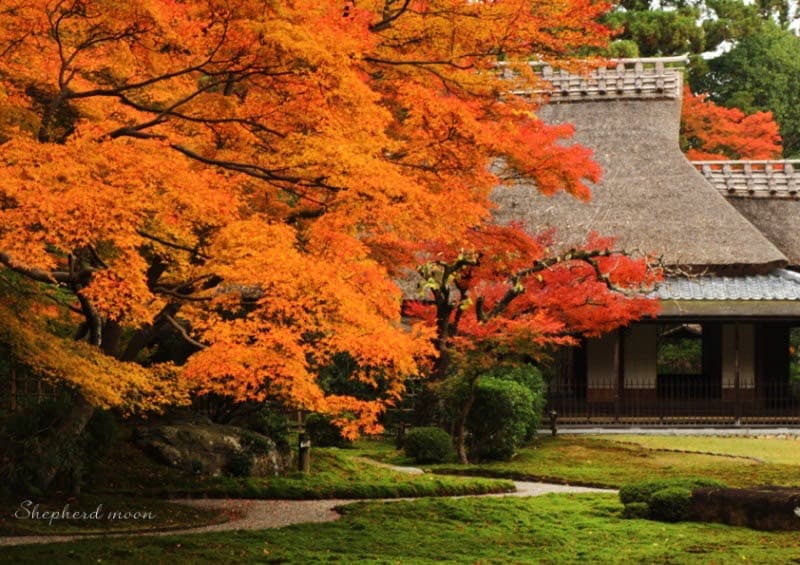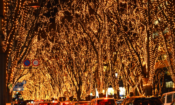まだ間に合う!奈良県の12月上旬まで楽しめる紅葉スポット厳選3選
秋も深まり、街の木々が美しい紅葉に染まる季節がやってきました。奈良県は、その歴史的な名所と自然の美しさが融合した魅力的な地域で、多くの紅葉スポットが楽しめる場所です。12月上旬までと、まだまだ紅葉を堪能できるこの時期に、特におすすめの紅葉スポットを厳選してご紹介します。心温まる奈良の風景を楽しんで、日常から一歩離れた特別なひとときを過ごしてみませんか?
1.奈良 長谷寺の紅葉を楽しむ
– 心癒されるひととき
奈良県桜井市に位置する長谷寺は、古くから信仰の対象とされている美しい寺院です。その魅力は四季折々の自然と文化の融合にあり、特に秋の紅葉は多くの観光客を魅了しています。このブログでは、長谷寺の紅葉の魅力、アクセス方法、そして見頃の時期をご紹介します。
長谷寺の概要と紅葉の魅力
長谷寺は、奈良時代に建立され、現在の本堂は江戸時代に再建されたものです。お寺には、観音菩薩が祀られており、多くの参拝者が訪れます。長谷寺の紅葉は、境内や周囲の自然に色とりどりの葉が彩りを添え、訪れる人々に感動を与えます。
特に、四季折々の風景を楽しむことができる長谷寺では、秋になると赤や黄、橙色に染まった木々が見事なコントラストを作り出し、心を奪われる瞬間が広がります。夕暮れ時には、ライトアップされた紅葉とともに幻想的な雰囲気が漂い、訪れる人に特別な体験を提供します。
アクセス方法
住所: 〒633-0112 奈良県桜井市長谷731-1
https://maps.app.goo.gl/R65YpHWJF2MmFVda8
開業: 686年 営業時間: 9:00分~17:00分
電話番号: 0744-47-7001
長谷寺へのアクセスは非常に良好で、公共交通機関を利用することができます。奈良市内からは、JR奈良駅から近鉄奈良線に乗り、近鉄桜井駅で下車後、長谷寺行きのバスに乗り換えます。バスで約20分ほどでアクセス可能です。長谷寺から徒歩圏内には、周辺の自然や文化財を楽しむことができるスポットも多く、散策には最適なエリアです。
また、車でのアクセスも便利で、御所市方面から国道169号線を利用して向かうことができます。長谷寺には駐車場が完備されており、周辺の紅葉を楽しんだ後には、お茶や地元の名産を楽しむことができる場所もあります。
紅葉の見頃と期間
長谷寺の紅葉の見頃は、例年11月中旬から下旬にかけてがピークです。この時期には、色とりどりの紅葉が楽しめるだけでなく、多くの色素と香り豊かな食材を使った地元料理や特産品も楽しむことができます。
特に、11月の中旬から下旬にかけては、数日おきに開催されるイベントや、紅葉に合わせた特別な行事が行われることもあります。この期間中は、長谷寺を訪れる観光客が増えるため、早めの計画をおすすめします。
おすすめの体験
長谷寺を訪れる際には、ただ紅葉を見るだけではなく、いくつかの体験を楽しむこともできます。例えば、境内内の散策路を歩きながら、ゆったりとした時間を過ごすのも良いでしょう。特に、秋の風を感じながら歩くと、心が癒されること間違いなしです。
また、長谷寺内にはお茶屋さんや休憩所がいくつかあり、紅葉を眼前に見ながら美味しいお茶や軽食を楽しむこともできます。地元の栗や柿を使ったスイーツも人気があり、紅葉狩りとともに味覚も楽しむことができます。
さらに、参拝を済ませた後は、周辺の観光スポットもぜひ訪れてみてください。少し足を延ばせば、奈良公園や法隆寺など観光名所も近くにあり、自然と歴史を同時に感じることができます。
終わりに
長谷寺の紅葉は、単なる観光地ではなく、自然の美しさと文化の深さを感じさせてくれる場所です。この秋、ぜひ長谷寺を訪れて、心温まる紅葉の景色を楽しんでみてはいかがでしょうか。美しい景色を堪能し、心豊かなひとときを過ごすことができます。長谷寺での秋のひとときを、あなた自身の目で確かめてみてください。
2.奈良の名勝 依水園の紅葉
1. 依水園の紹介
依水園(いすいえん)は、奈良県奈良市に位置する、美しい庭園として知られています。元々は、江戸時代中期(18世紀)に作られたものであり、茶人の岡田半江が設計したとされています。依水園は、日本の伝統的な庭園デザインを活かしつつ、訪れる人々に心安らぐひとときを提供しています。四季折々の自然の美しさを楽しむことができ、特に秋の紅葉は全国的に有名です。季節ごとに異なる風景を楽しむことができるため、年間を通じて多くの観光客に親しまれています。
2. 紅葉の魅力
依水園の紅葉は、例年11月中旬から下旬にかけてピークを迎え、鮮やかな赤や黄色の葉が園内を彩ります。特にモミジやカエデの木々が多く、庭園内の美しい池や橋とのコントラストが非常に魅力的です。紅葉のシーズンには、園内に設けられた遊歩道を散策しながら、さまざまな視点から秋の景色を楽しむことができます。また、園内の建物や石灯籠と紅葉の組み合わせも美しく、写真撮影スポットとしても人気があります。
3. アクセス情報
所在地: 〒630-8208 奈良県奈良市水門町74
https://maps.app.goo.gl/S7GAGV3VViiKTzpa8
営業時間: 9:30〜16:30 電話番号: 0742-25-0781
依水園へのアクセスは非常に便利です。奈良市内からの公共交通機関でのアクセスを以下に示します。
- 電車でのアクセス: 近鉄奈良線「近鉄奈良駅」から徒歩約15分。駅を出たら、旧市街を散策しながら向かうことができます。
- バスでのアクセス: 奈良交通バス「依水園前」下車すぐ。奈良駅から直通のバスも運行されており、アクセスが簡単です。
また、周辺には他の観光名所も多く、興福寺や奈良公園、東大寺など、奈良の文化や歴史を深く知ることができるスポットが点在しています。観光をしながら紅葉を楽しむために、依水園は絶好のロケーションとなります。
4. 施設情報
依水園はその美しい自然だけでなく、各種施設も充実しています。園内には、休憩所として利用できる茶室があり、紅葉を眺めながら、抹茶や和菓子を楽しむことができます。季節限定のメニューも用意されるため、訪問する際にはぜひ試してみてください。また、売店では地元の特産品やお土産も販売しています。
5. 紅葉の楽しみ方
紅葉のシーズンは、特に多くの人々が訪れるため、混雑が予想されます。おすすめの楽しみ方としては、早朝や夕方の時間帯に訪れることです。静けさを感じながら、紅葉の美しさを独り占めできる贅沢な時間を過ごせるでしょう。また、園内には多くのベンチが設置されているので、休憩しながらゆっくりと紅葉を楽しむこともできます。
6. まとめ
依水園の紅葉は、その美しさやアクセスの良さから、奈良を訪れる観光客にとって外せないスポットです。豊かな自然の中で、歴史を感じながら、心穏やかなひとときを過ごしてみてはいかがでしょうか。紅葉の期間は短いですが、その分特別な時間を提供してくれることでしょう。ぜひ、この機会に奈良の依水園で、素晴らしい秋の風景を体験してみてください。
3.奈良の公園の紅葉
はじめに
奈良は日本の古都として知られ、歴史的な遺産や文化財が数多く残る場所です。その美しい自然景観の中でも、特に秋の紅葉は見る人の心を魅了します。本記事では、奈良にある公園の紅葉について、アクセスや紅葉の期間を含めてご紹介します。
3.奈良公園の概要
奈良公園は、奈良市の中心部に位置し、広大な面積を誇る公園です。この公園は歴史的な名所である東大寺や春日大社などと隣接しており、多くの観光客が訪れるスポットです。また、公園内には奈良のシンボルである奈良鹿が自由に歩き回っており、訪れる人々にとって独特な体験を提供しています。
アクセス
所在地: 奈良県
https://maps.app.goo.gl/xSbAANMG9FhKJBAw5
面積: 5.11 km² 営業時間: 24 時間営業
電話番号: 0742-22-0375 開園: 1880年
奈良公園へのアクセスは非常に便利です。最寄りの駅は、JR奈良駅または近鉄奈良駅です。これらの駅から公園までは徒歩で約15分程度で到着します。奈良駅からは、道中にある観光名所を楽しみながら向かうことができるため、散策しながら移動するのもおすすめです。また、駅から公園までの道のりには、地元の飲食店やお土産屋も点在しているため、寄り道しながら散策を楽しむことができます。
紅葉の期間
奈良公園の紅葉は、例年11月中旬から12月上旬にかけて見頃を迎えます。この時期になると、公園内のさまざまな木々が赤や黄に色づき、美しい風景を作り出します。特に、公園内の大きなイチョウの木やモミジは、鮮やかな色合いで訪れる人々を楽しませてくれます。毎年、多くの観光客がこの期間を狙って奈良を訪れ、紅葉の美しさを堪能しているのです。
その中でも特に人気のスポットは、春日大社や東大寺周辺です。これらの場所では、歴史的な背景を感じながら紅葉を楽しむことができ、絶好の写真スポットにもなっています。また、公園内の広場や池の周りでは、紅葉を反射させた美しい景色を撮影することもできます。
紅葉を楽しむためのポイント
奈良公園での紅葉観賞をより楽しむためには、いくつかのポイントがあります。まず、早朝や夕方に訪れることをおすすめします。この時間帯は、人が少なく、静かな環境の中で紅葉を楽しむことができます。また、柔らかな光が差し込むことで、紅葉がより美しく見えるため、写真を撮るにも最適な時間です。
次に、寒い季節の訪問になるため、服装にも注意が必要です。暖かい服装で訪れることをおすすめします。特に風が強い日には、防寒対策をしっかり行いましょう。軽食や温かい飲み物を持参するのも、特別な紅葉観賞体験を演出する一助となります。
さらに、奈良の特産品やグルメを楽しむことも併せて計画すると良いでしょう。奈良地方の名産である奈良漬や、地元の食材を使った和食を楽しむことで、心も体も満たされます。公園近くにあるカフェや食堂で、休憩を挟むこともおすすめです。
まとめ
奈良公園の紅葉は、古都ならではの歴史的背景と美しい自然が融合した、他では味わえない素晴らしい体験です。アクセスも良好で、訪れやすい場所なので、秋の訪問にはぴったりです。特に紅葉の見頃である11月中旬から12月上旬にかけて、ぜひ奈良公園を訪れて、その美しさを自分の目で確かめてみてはいかがでしょうか。紅葉を楽しむだけでなく、奈良の歴史と文化も体験できるこの特別な時期を、一生の思い出にすることができるでしょう。






